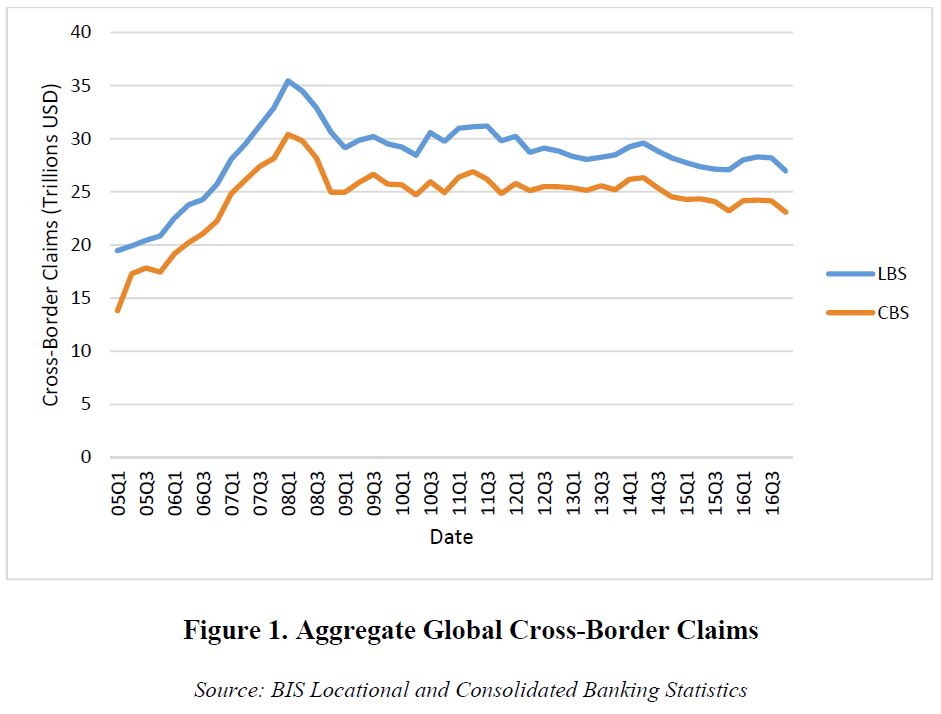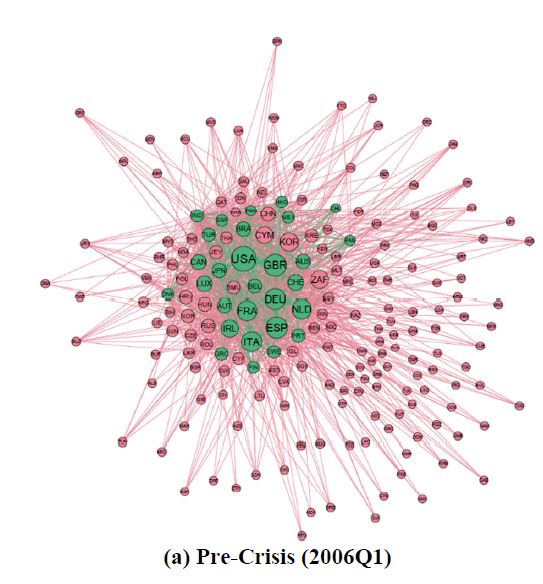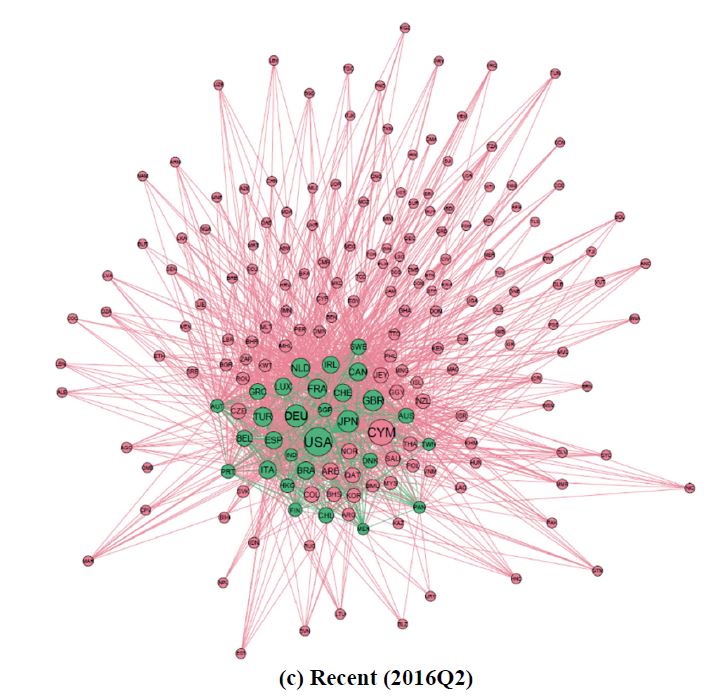An IMF working paper “The Global Banking Network in the Aftermath of the Crisis: Is There Evidence of De-globalization?” released today, shows that contrary to popular belief, the Global Banking Network has not shrunk since the GFC in the simple way often thought. Using complex and innovative modelling, they conclude that the banking world in some ways is connected more deeply, and with greater complexity than before. This means that players in one location could be impacted more severely by events in other geographies. They conclude that the hidden dynamics of the global banking network after the crisis suggest that the assertion that cross-border lending has shrunk globally seems to miss out significant details. They refrain from assessing the risk impact of this observation.
However, we conclude, like our digital world, global banking is more financially networked than ever, suggesting that risks could be propagated widely and in unexpected directions.
The global financial crisis in 2008-09 underscores the unique role of financial interconnectedness in transmitting and propagating adverse shocks. Previous literature stresses the significance of network structure in generating contagion, lays out detailed mechanisms of contagion through balance-sheet effects, is followed by a large body of theoretical and empirical research on interbank markets, mostly within a single country or region, that focuses on modeling banks’ behavior in response to shocks in the financial system. Cross-border implications of the banking network, however, are mostly ignored due to scarcity of data and rich country-level heterogeneity that may lower the explanatory power of a unified framework.
The sharp fall in global cross-border banking claims after the crisis has been persistent, either measured in Bank for International Settlements (BIS) Locational Banking Statistics (LBS) or BIS Consolidated Banking Statistics (CBS). This persistent aggregate decline in cross-border banking claims has been considered evidence of financial deglobalization. In this paper, we consider the validity of the financial de-globalization argument by studying the evolution of the global banking network before, during and after the crisis, with a particular focus on the aftermath of the crisis. Instead of trying to establish the role of the network in propagating the crisis at a global level, we take the role of the global banking network as given and seek to investigate the impact of the crisis on the network. In this context, our key contributions to the literature are twofold: (i) we measure and map the global banking network using a model-free and data driven approach; and (ii) we analyze the evolution of the network using network analysis tools, including some novel applications, that are relevant given the characteristics of the global banking network and the available data.
The foremost challenge in constructing the global banking network is to map and identify an accurate and comprehensive network structure using the available data on cross-border banking flows. Researchers face a tradeoff between data coverage and frequency. High frequency data, such as banks’ daily transactions, often contain a limited number of banks within a country, while datasets with a good coverage of global lending mainly report country-level aggregate statistics, and are updated infrequently. This challenge is further complicated by the difficulty in identifying the composition, sources and destinations of bank flows, primarily due to the use of offshore financial centers as important financial intermediaries. Not only are global banks able to conduct cross-border lending via entities in their headquarters and offshore financial centers, but also they can lend domestically through subsidiaries and/or branches within the border of the borrower countries. BIS International Banking Statistics (IBS), through its two datasets (LBS and CBS), offer the best available data to map the international bank lending activity across countries. This is especially the case of the CBS dataset, which consolidates gross claims of each international banking group on borrowers in a particular country, aggregating those claims following the nationality of the parent banks. This nationality-based nature of CBS is an advantage over LBS, which follows a residency-based principle, and thus obscures the linkages between the borrower country and the parent bank institution, when lending originates in affiliates located in third countries (e.g., off-shores financial centers). A disadvantage of using CBS is that it registers the full claims of the affiliates, independent of how those assets were funded (e.g., a claim of a foreign affiliate that is fully funded with local domestic depositors is still counted as a claim from the country of the parent bank on the borrower country where the affiliate is located). In order to avoid this overstatement of financial linkages, which are large in the case of emerging countries as shown in the next section, we combine BIS CBS data with bank level data, taking into account the claims of foreign affiliates and the local deposit funding used by subsidiaries and branches.
We use the improved measure of cross-border banking linkages to onstruct a sequence of global banking networks, and apply tools from network theory to analyze the evolution of economic and structural properties of the network. We take a step further to incorporate this important discussion into our choice of metrics to identify important players and trace the structural evolution of the global banking network. We provide an in-depth discussion of network measure choice based on the structural context of a core-periphery, asymmetric and unbalanced network structure and in the economic context of characterizing banking flows at the country level.
We introduce measures of node importance that capture distinct aspects of global banking linkages. In particular, we use recursively defined Katz-Bonacich centrality and authority/hub measure to characterize country importance based on its connection to and dependence on other important countries, as well as a novel application of modularity in order to capture the regional fragmentation of the network. The flexibility of our network configuration allows us to use a small number of network metrics to reveal distinct aspects of network structure and node importance.
We find that the overall shrinkage of cross-border bank lending after the crisis, which has been the key argument behind the claims on financial de-globalization, is also reflected in the average number of links and their strength in the global banking network.
However, rich details on the evolution of the network suggest that this argument is overly simplified.
While connections within traditional major global lenders (banks in France, Germany, Japan, UK, and US) became sparser, many non-reporting countries located at the periphery of the network are more connected, mainly due to the rise of non-major global lenders out of Europe. Measured in metrics of node importance, these lenders have been steadily climbing up the rank, resulting in a corresponding decline of European lenders in status and borrowers’ decreasing dependence on traditional lending countries. Moreover, we find substantial evidence indicating increasing level of regionalization of the global banking network. Even though post-crisis retrenchment of major global and non-major European banks’ operation in the aggregate was just partially offset by the rest of the BIS reporting countries’ regional expansion, their targeted expansions have increased regional interlinkages through both direct cross-border and affiliates’ lending. More formally, using network modularity as a novel application to assess the quality of network cluster structure based on region divisions, we find that this measure increases after the crisis, thus indicating, from the perspective of network theory, that some form of regionalization characterizes the post-crisis dynamics of the global banking network. Finally, we also confirm this regionalization process through a regression analysis of the evolution of cross-border lending. After controlling by geographical distance and trade relationships as well as lender and borrower characteristics, we find a statistically significant increase in cross-border lending when both borrower and lender belong to the same region, especially in the case of peripheral lenders during the post-crisis period.
We show that without proper adjustment, country-level banking statistics suffer from multiple data issues that distort the actual role of each country in cross-border lending, and increase the difficulty of accurately detecting key players in the network. We find evidence confirming the overall shrinkage in the scale of cross-border bank lending using a variety of network analysis tools. Moreover, these methods capture rich dynamics that occur inside the global banking network and are not captured by traditional aggregate indicators.
Using a set of centrality measures with meaningful economic interpretations, we delve substantially deeper to capture the interconnectedness faced by each country. While the structural stability of the highly concentrated global banking network is mainly due to the stability of major global lenders, we observe decline in importance for non-major global European lenders and a corresponding rise in the ranks for lenders from other region, comprised of mostly emerging market lenders. The hidden dynamics of the global banking network after the crisis suggest that the assertion that cross-border lending has shrunk globally seems to miss out significant details.
NOTE: IMF Working Papers describe research in progress by the authors and are published to elicit comments and to encourage debate. The views expressed in IMF Working Papers are those of the authors and do not necessarily represent the views of the IMF, its Executive Board, or IMF management.




